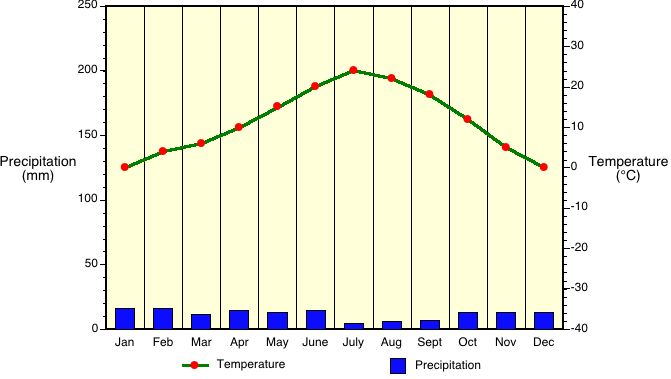
This graph shows the mean monthly temperatures and precipitation levels for a city called Lovelock, NV. This is located about 100 miles southeast of Black Rock Desert, but has similar climate averages throughout the year. Graph credit physicalgeography.net.
The Black Rock Desert is located in a rain shadow that is caused by the Sierra Nevada mountain range. The peaks of the Sierra Nevada mountain range can reach as high as 10,000 feet above sea level, effectively cutting off the source of moisture coming from the western side of the mountains. A rain shadow is the dry area on the lee side of a mountain range, the precipitation causing weather is being blocked by the mountains and makes a dry shadow on the other side of the mountainous area. The precipitation is released at the top of the mountain, the air advancing over into the valley area and as it descends downward, it then gets warmer and drier.
http://en.wikipedia.org/wiki/Rain_shadow
 This illustration gives an example of a rain shadow. The location of the Sierra Nevada Mountains are the cause of the Black Rock Desert being in a rain shadow.
This illustration gives an example of a rain shadow. The location of the Sierra Nevada Mountains are the cause of the Black Rock Desert being in a rain shadow.Precipitation on the playa is less than 10 inches yearly, occurring mostly as snow during the winter months. This light precipitation helps to keep the silt at the flat bottom of the playa compacted. When this silt is disturbed by wind or human activity, there are more occurrences of dunes on the playa. There is research currently being conducted about how much of these dunes are being caused by humans and how much of them occur naturally. This was partly brought to light after seeing the presence of the dunes increase after the beginning of the Burning Man Festival at the Black Rock Desert in the late 1990s.

This photo shows the dunes that have formed on the surface of the playa due to winds and loose silt.
photo credit
July/August issue of Nevada Magazine

In this photo there is a dust storm in action, forming from the dry, warm air coming down the mountains on the other side of the playa.
Photo credit http://www.fredmiranda.com/forum/topic/1040905
Sources
http://en.wikipedia.org/wiki/
http://www.britannica.com/
http://www.physicalgeography.
http://en.wikipedia.org/wiki/
No comments:
Post a Comment